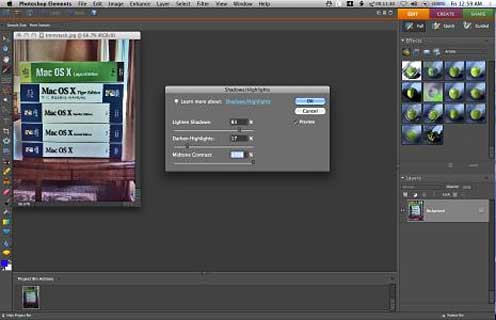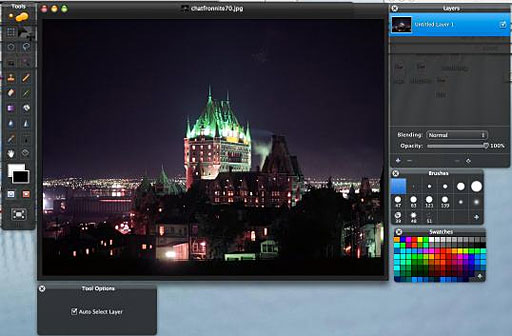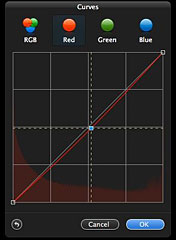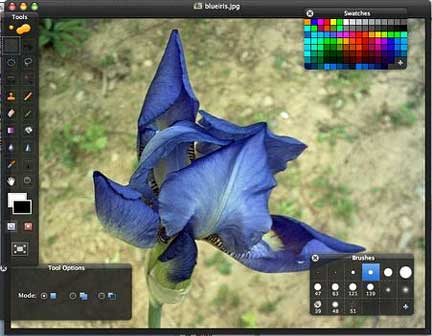Back in March, I posted a review of the new(ish) bitmap
graphics and photo editing program Pixelmator, then at version 1.1.3,
noting that Pixelmator is being positioned by its developers as a
Photoshop challenger - at least to Photoshop Elements - but that the
the bar was about to be raised with the imminent release of Photoshop
Elements 6 for the Mac.
PSE 6 has been out for a couple of months now and has indeed raised
the features and value ante, being offered at the same price as before
(currently $79.99 at Amazon.com),
but now Intel native (Universal Binary) - and with a raft of completely
new features, including some very cool functions based on Adobe's
proprietary Photomerge technology (like automated panorama stitching
and correction and combining the best facial expressions and body
language from a series of shots to create a single, perfect group shot,
a new Quick Selection Tool reduces a once time-consuming
select-and-adjust task to a single click, Adobe's Bridge photo
organizer and browser application, a Color Curves control, which
augments the color cast and skin tone correction tools, an improved
conversion tool that converts color images into true nuanced
black-and-whites, a Correct Camera Distortion tool, and more).
The bar has been raised indeed.

Photoshop 6 for Macintosh
This month, the Pixelmator folks responded with the release of
Pixelmator 1.2 "Draftsman" (a free update for registered Pixelmator
users) with new rulers, guides, curves, auto enhance, color balance,
and polygonal lasso tools.

Pixelmator 1.2
Rather than re-ploughing recently turned ground, I'll refer you to
the earlier review for discussion of Pixelmator's basic features and
capabilities; we'll concentrate on what's new and improved in
Pixelmator 1.2.

 I
especially love Pixelmator's new Curves tool - the most intuitive and
and slickest I've ever used for adjusting tonal range or making precise
adjustments to individual color channels in an image.
I
especially love Pixelmator's new Curves tool - the most intuitive and
and slickest I've ever used for adjusting tonal range or making precise
adjustments to individual color channels in an image.
There is also a new Color Balance tool for controlling the overall
color mixture in an image when you're doing color correction work.
Pixelmator 1.2 introduces an enhanced rulers tool, which is helpful
for the exact positioning of images or elements. Users can also adjust
the ruler's origin to measure from a specific point on an image and
change the units of measurement to pixels, inches, centimeters,
millimeters, points, picas, or percent. Guides appear as nonprinting
lines that float over the image, which you can add, move, remove, and
lock. You can also utilize the grid to lay out elements symmetrically
and the snap feature to position selection edges precisely.

The new auto enhance tool is intended to optimize less-than-perfect
images with a single click, convenient if you're in a hurry and sure to
be popular with new or casual users. It works quite well, I would say
pretty much on par with the similar tool in Photoshop Elements, but
personally I prefer to tweak my shots with more precisely nuanced
correction tools if I have the time.
The new polygonal lasso tool is useful for drawing straightedged
segments of a selection border.
In addition to a free transform tool, Pixelmator 1.2 Draftsman
features new and updated help documentation, enhanced Automator actions
and transform tools, minor user interface and compatibility
improvements, as well as bug fixes.
A concise observation would be that PSE has more tools, but
Pixelmator's are nicer to use.
I do continue to miss Elements' Lighting and Shadows adjustment
panel, especially the lighten shadows/ darken highlights controls, but
Pixelmator's exposure adjustment control compensates somewhat, and is
less complex to use.
 The PSE Spot
Healing tools are also conspicuous by their absence. Pixelmator's Clone
Stamp Tool partly compensates, but it's a lot clunkier solution than
the PSE pair, and the stamp shaped cursor is nowhere nearly precise
enough for close work.
The PSE Spot
Healing tools are also conspicuous by their absence. Pixelmator's Clone
Stamp Tool partly compensates, but it's a lot clunkier solution than
the PSE pair, and the stamp shaped cursor is nowhere nearly precise
enough for close work.
On the other hand, a really cool Pixelmator wrinkle is that the
currently selected tool's icon gets magnified in the tool palette, and
the icons are strikingly attractive. On the downside, I really dislike
having to switch to a Move Tool from a Marquee Tool in order to move
something around. I much prefer to be able to select and
Option-drag.
Task progress - even simple things like image saves - continues to
be sluggish on my 1.33
GHz G4 PowerBook. I wouldn't keep kvetching about this (those who
say it's time to upgrade to an Intel Mac have a point, and I'm on the
case), except that Low End Mac's readership is somewhat weighted toward
users of older hardware. I anticipate that my speed complaints would be
eliminated on an Intel Mac.
Your GPU Matters
The power and sophistication of your Mac's graphics support also
will be a significant factor in Pixelmator's liveliness and
responsiveness on your Mac. Claimed to be "The World's First
GPU-Powered Image Editor", Pixelmator relies heavily on OS X's Core
Image technology, which uses your Mac's video card for image
processing. Core Image utilizes the graphics card for image processing
operations, freeing the CPU for other tasks, so if you have a
high-performance card with a lot of video RAM, you should find
real-time responsiveness across a wide variety of Pixelmator operations
enhanced substantially, so one can deduce that you're going to get
substantially better performance with Pixelmator on a Mac Pro or
MacBook Pro with a real graphics accelerator card and 128 MB or more of
dedicated video RAM, than with a MacBook or Mac mini with Intel GMX 950
or 3100 integrated "vampire video" that shares RAM with the system.
In addition to Core Image, Pixelmator harnesses the power of Mac OS
X's Open GL, Automator, ColorSync, Spotlight, and many other
technologies. Pixelmator was built exclusively for Mac OS X, and
it shows.
One more thing: Pixelmator supports over 100 different file formats.
You can open and save in PSD, TIFF, JPEG, PNG, PDF, EPS, and scores of
other image formats. Above all, Pixelmator can open and save Photoshop
files with layers. You are never alone with Pixelmator.
Pixelmator's
translucent black windows continue to be a visual feast, although IMHO
it detracts from the program's functionality somewhat, and the new
Photoshop Elements 6 for Mac, with its charcoal UI theme, appears to be
a frank homage to Pixelmator's design influence. To reprise what I said
in the earlier review, the Pixelmator UI is pretty but more than a bit
distracting, and I find myself squinting to distinguish some of the
tool selections, whose rendering is more than a bit murky in some
instances - and also too-easily losing track of the cursor position.
Also, with my favorite Leopard desktop picture, which happens to have a
lot of black area, Pixelmator's toolbar just sort of blends in and
disappears.
I don't want to disparage the look. It's interesting and
distinctive, a treat to look at, and the developers have hinted that
there is a cool new feature coming that will be related to window
transparency. However, Elements' more subdued theme is more
practical.
Pixelmator is getting better, and this 1.2 release addresses several
of the complaints and concerns I expressed in the previous review.
However, it's still not quite there yet for me.
I like using Pixelmator for its relatively quick startup and less
complex and ponderous interface than Photoshop Elements - especially
Elements 6. However, for production image editing when I'm in a hurry,
I'm still inclined to go for either the power and versatility of PSE or
on the other hand the incredible user-friendliness and lightning speed
of Digimage Arts' venerable but still superb
Color It! 4.5, a Carbon application with roots that dates back to
the Mac System 7 era, but whose slickness, simplicity, and interface
conventions the Pixelmator and PSE developers could both profitably
study and emulate
System requirements: Pixelmator requires Mac OS X version 10.4.9 or
later, but 10.5 is recommended. Core Image supported graphics card
(recommended), some features require iLife.
More information, along with the 30-day Pixelmator trial, is
available as a free download at the Pixelmator website.
Pixelmator 1.2 is available Smith
Microfrom $60 via electronic download. Pixelmator 1.2 is a
free update to current Pixelmator customers.
Go to the Miscellaneous Ramblings Review index.


